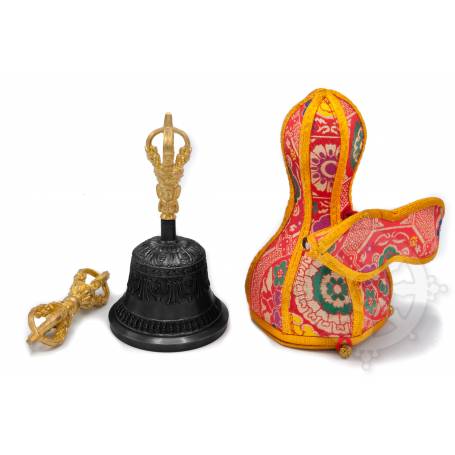Black Bell & Dorje from Dehradun (Large size) - with case - Art of India
Dehradun (India) is the undisputed world capital of the best bells manufacturers. Their expertise is unparalleled throughout Asia. Most bells the-dhar...
Description
Dehradun (India) is the undisputed world capital of the best bells manufacturers. Their expertise is unparalleled throughout Asia. Most bells the-dharma-store.com proposes come from this area and have been carefully selected by an experienced Tibetan rituals master. Our bells are finely crafted with many symbolic details within and without. The bell handle and the dorje are fully gilded with 24K gold. These instruments are usually combined in rituals: - The Tibetan bell represents the feminine principle, the perfection of wisdom and direct experience of emptiness. - The five-pointed vajra or diamond-thunderbolt represents the masculine principles: the four doors to liberation, the four joys, the four directions and the four elements. The bell or drûlbu still stands in the left hand and the Vjra or Dorje in the right hand.
CAUTION: never force the thread connecting the half dorje and the body of the bell: being made of metals of different strengths, this would result in a fracture of the thread.
Data sheet
Data sheet
- Weight
- 580
- Matter
- Metal
- Origin
- Dehradun (India)
- Height
- 18.5
Tips for ritual objects
A ritual object, like any instrument of religious practice, must be respected with circumspection. We remind you here some ethical rules:
- Ritual objects are objects of practice that have the power to protect us and help us on the path to liberation. They should therefore be treated with respect, that is, kept away from the ground and places where people sit or walk or dirty places.
- Outside ritual moments, objects should be protected by an appropriate holster for rest and / or transport and not mixed with, for example, dirty or soiled equipment / objects.
- Ritual objects are not decorative objects. To acquire a ritual object, underlies that one wishes to use it for its practice and one must therefore devote a privileged place where it will remain outside the moments of practices.
- If you no longer want to keep your ritual object, do not throw it away! Please contact the nearest Buddhist Center and make a donation. In doing so, this object will give you merit until the end of your relationship.
This is a few non-exhaustive rules of Buddhist ethics that you are free to respect or not.
Warning
All our objects are handmade. Each piece is unique and it is impossible to reproduce exactly the same. Slight differences may therefore appear in the shapes, proportions, colors and / or materials used in our descriptions and specification sheets.
The silver (metal) used in Nepal is always composed of an amalgam and is most often plated on metal parts. Most of the stores that sell 925 sterling silver products from Nepal are fraudulent!
Likewise, some stones considered semi-precious from Nepal or India are actually stones reconstituted from powder of semi-precious stones, such as turquoise or coral. Nevertheless, they seem to retain the properties of the original stones. In the case where reconstituted stones are used, we always specify it in the specifcation sheeet.
The items represented by this symbol are labeled "Monastery Quality" and are considered to be of superior quality in their category.








